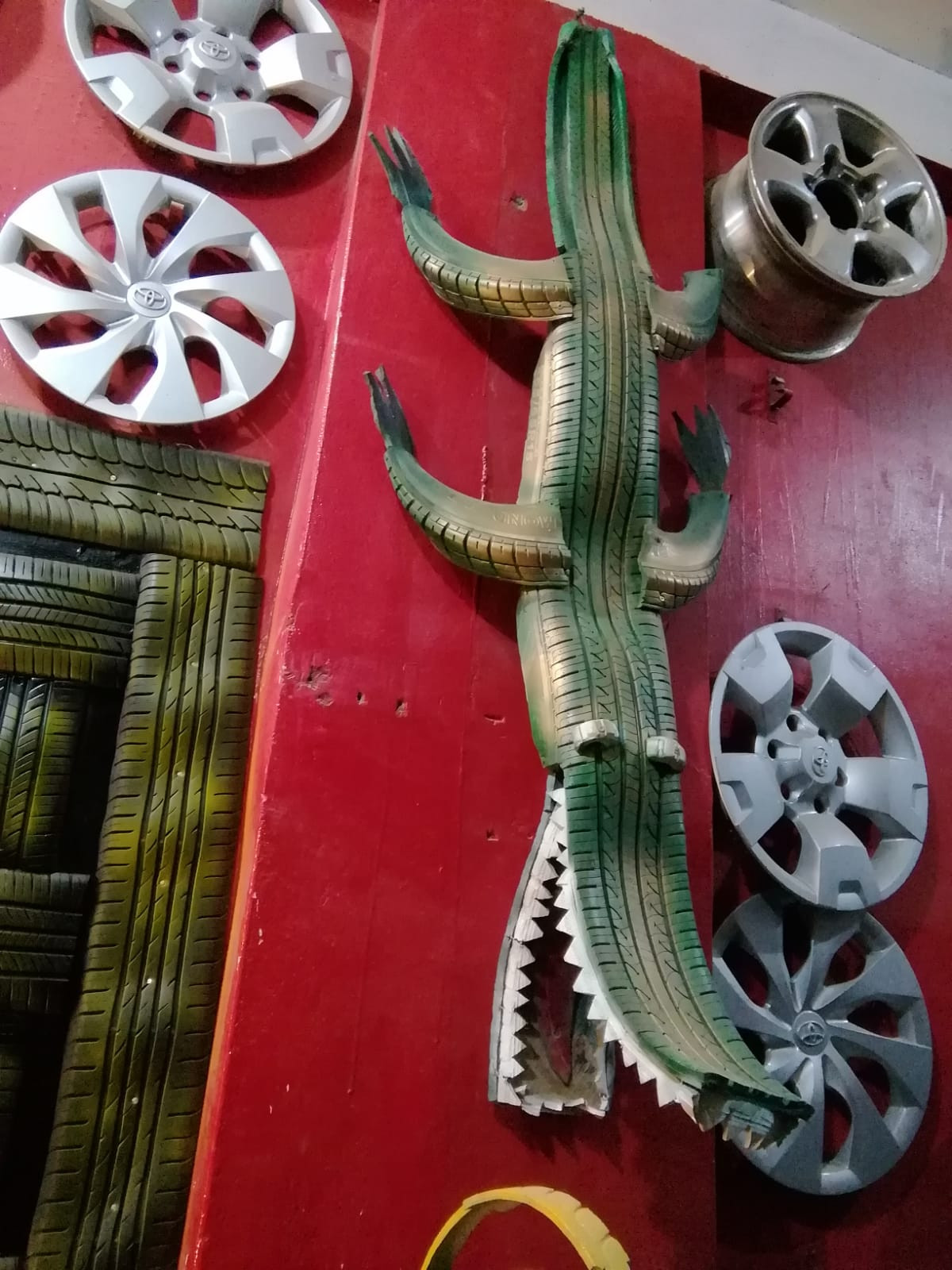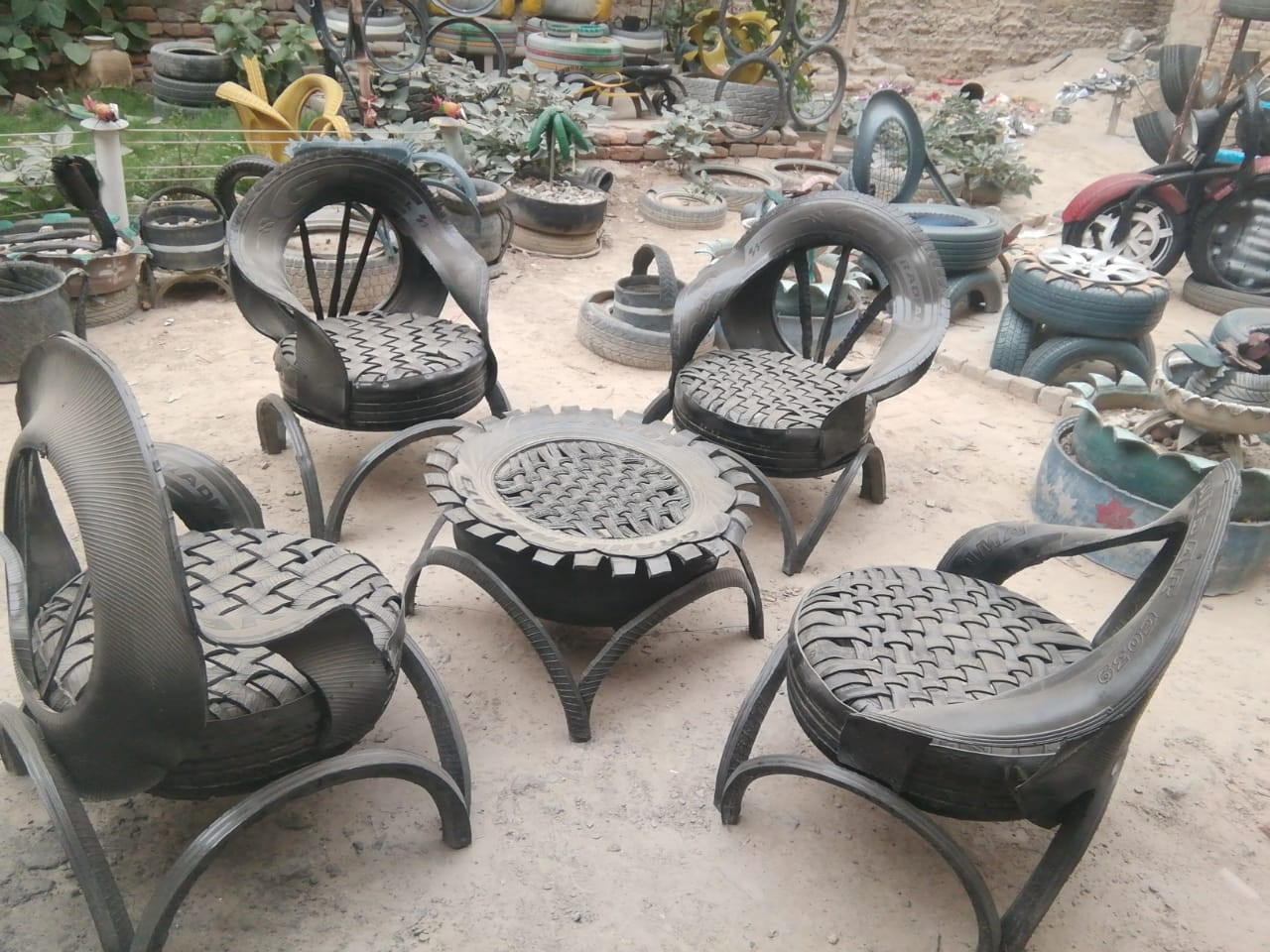During the Covid-19 lockdowns, brothers Atique Ullah and Siddique Ullah from Quetta begun making inventive 3-D structures from tyres, which they had in their shop at a wholesale market in the city. “Initially our own tire community members [were] unhappy with us because we had a narrative that rather than selling these damaged tyre so that people burn it and pollute the environment, why cannot we use it for something positive?” Atique Ullah said. “Our father was the first one to appreciate our work. I remember the day he came to the shop and saw the lamps and chairs which we made initially, he started smiling [at],” he added.
The brothers quickly got creative in their designs, using materials they had on hand at the shop; the first things they made were from a rickshaw tire and motorbike tire. “The reason for making a wall clock on rickshaw and motorbike tires is that these two types of vehicles are always in hurry,” Atique said. “They also need to travel slow and have patience.” After this, they made tire seats which he claims have multiple benefits. Unlike wooden or aluminum materials, they are rust and insect resistant and can be spruced up over a few years with a coat of paint. Although neither brother has a background in art or design, they both seem to possess a natural ability and are full of ideas about how to turn trash into treasure.

Another of the brothers’ unique designs is a coffee table that resembles a kareez or water tunnel. “This table is really a depiction of our water system. If you switch on the lights inside this and look from above, it will give you a 3D- Tunnel look. If you have gone to Pishin district of Baluchistan it was all based on Kareez system but they all have dried,” Atique Ullah said. “This [furniture] will always be bought by [the] elite class to display in their workplace or drawing room. Whenever they will see this, they will realize how important Kareez is to our society, and we should not neglect it.”
Designs with meaning
Near the back door of the shop leading to a garden also sat a giant tractor painted red, which turned into a 3-D tunnel when the lights were switched on, depicting a coal mine. “Nothing here is without any imagination or [a] message,” Atique Ullah sai. “This coal mine tunnel is again a message to coal miners who do not think how a worker feels suffocated inside. You can an oxygen pipe where and a fire extinguisher, if both these facilities are available inside a coal mine, the work will never die of suffocation. This again is for elite to understand the poor and his hardships.” When the brothers spoke about their work, Atique Ullah’s environmentalist side shone through while his brother Siddique seemed to be more involved in the physical creation of designs.
The brothers started their tire art in the garden of their backyard, which is filled with colorful pots, animals, plants, and trees, during lockdown. Among the items in the garden are initial experimental designs that the brothers made before they had much expertise. “Whatever I used to see, I started making it from tires, especially the garden decor,” Siddique said. “As my skills got developed, I started making other designs. Someone [must] take an initiative and I think here in Pakistan we have taken this initiative.”
When they started, the brothers said they didn’t have any tools and didn’t even know how to cut the tires they wanted to use in their designs. But since they were cooped up at home because of Covid, they learned how to make these inventions one their own, finding tools that would help them bring their ideas to life. “It is like I daydream all the time now about tire art,” Siddique said. “I sleep and think about it, I come to the shop and look around and go in [my imagination to think about] what new can be done.”
Artists with no gallery

The brothers said they were impressed by the Indian Movie “3 Idiots” where Amir Khan, who plays the character “Rancho,” used car batteries and an inverter to produce light in the university when the lights when off. They’ve channeled some of that energy into their work; One of their designs includes a water cooler made from a Jeep tire. “While fixing our own water cooler at home, I saw the mechanism and thought that steel catches rust, plastic creates a smell, but tires are free of both [these] issues, so why not make a water cooler out of it?” Atique said. “Inspired by “3 idiots,” I used a car radiator fan between the tire holes with a small machine and here is the cooler in front of you.”
Unlike art students at universities in Pakistan who have a venue to display their designs, Atique and Siddique have imaginative works without any place to display them. The brothers say they do not have a social media page and know very little about the market for art. They have, however, been approached by many TV channels and art galleries that are interested in their designs. They believed that people from other provinces in Pakistan making such designs would have been handpicked by art schools, which would provide them a diversion from their lives surrounded by tires. They said they would like their art to be seen among the sculptures of national heroes placed around the city so they might be able to convey the messages behind their creations, which speak to themes in Pakistani society, while also taking part in pollution control by reusing these old materials.
Mujtaba Javaid is a freelance writer. All information and facts provided are the sole responsibility of the writer.
